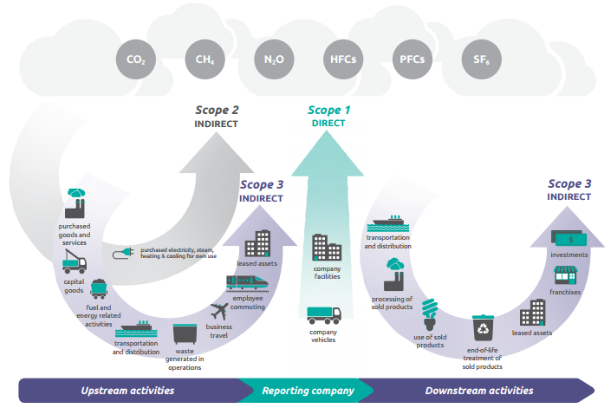What is the GHG Protocol?

You will most likely know that the need for reducing greenhouse gas emissions is a hot potato right now. The GHG Protocol emerged out of this necessity and is meant to help countries and companies alike to measure and manage their greenhouse gas emissions. It came about as part of the Climate Program and is the result of a report showing the need for more standardized methods of measuring and reporting on GHG emissions.
But what exactly is the GHG Protocol? Read on for a full breakdown of the GHG Protocol, who uses it, and what the different standards are.
What is the GHG Protocol?
Established in 1998, the Greenhouse Gas Protocol (GHGP) is an organization that was formed through a partnership between the World Resources Institute and the World Business Council for Sustainable Development. It helps companies to reduce their greenhouse gas emissions by setting standards to help them manage their emissions. In other words, they provide “standards, guidance, tools and training for business and government to measure and manage climate-warming emissions.” The GHG Protocol is most well known for its classification of scope 1, 2, and 3 emissions.
What does the GHG Protocol do?
The GHG Protocol works closely with governments, industry associations, NGOs, businesses and other organizations in order to develop comprehensive global standardized frameworks. These frameworks help organizations measure, manage, report and reduce their carbon emissions.
The GHG Protocol Standards evolved out of the complex global problem of climate change, and the catastrophic rising global temperatures due to greenhouse gas emissions that are caused by human activity. The standards aim to offer a much needed data-driven approach to the global reduction of emissions and the GHG Protocol standards allow organizations to discover the biggest “hot spots” in their value chains – in other words, identifying which activities generate the most emissions. This insight “allows businesses to focus on achieving the most meaningful reductions, not only from within their operations, but across global value chains.”
WRI/WBCSD Greenhouse Gas Protocol (GHGP), WorldResourcesInst
Who uses the GHG Protocol?
The GHG Protocol standards are aimed towards the private and public sector, value chains, products, cities, and policies. As “the world's most widely used greenhouse gas accounting standards” the GHG Protocol has been adopted by many companies and organizations. A study in 2016 found that 92% of fortune 500 companies used the GHG Protocol “directly or indirectly through a program based on GHG Protocol.”
The Paris Agreement saw countries committing to the reduction of greenhouse gas emissions to keep the global temperature rise below 1.5 degrees. Because of this, many cities around the world have committed to using the GHG Protocol, as well as there are increasingly more countries using it on a national level. It helps cities and countries “design climate mitigation goals, assess and report progress toward goal achievement, and estimate the greenhouse gas effects of policies and actions.”
GHG Protocol and scope emissions
The GHG Protocol is most famous for its scope emissions classification; “corporate emissions come from a variety of sources, which are grouped into ‘scopes’.” The three scopes are set out as followed:
- Scope 1: Emissions that occur as a direct result of the company’s own operations
- Scope 2: Emissions generated from the consumption of purchased electricity, steam, heat and cooling.
-
Scope 3: Indirect emissions that occur in the supply chain, including upstream and downstream operations.

Scope emissions, GHG Protocol
Measuring and managing scope 3 emissions is a tremendous task, and can be a tedious undertaking. However, it is a very necessary one; “for many businesses, scope 3 emissions account for more than 70 percent of their carbon footprint.” Our guide, How to start managing your supply chain emissions, will give you a comprehensive overview of the scope emissions of your supply chain and will guide you through how to get started with managing your supply chain's carbon footprint.
What are the GHG Protocol Standards?
The GHG Protocol provides standardized frameworks for companies, organizations, cities and even countries to help them reach their climate goals. The GHG Protocol standards and who they are intended for are set out as follows:
- Corporate Standard: The GHG Protocol for Corporate Accounting and Reporting Standard is meant for organizations preparing a corporate-level GHG emissions inventory. This standard provides instruction and recommendations for companies and other organizations and is meant to help them build an effective strategy to reduce GHG emissions as well as increase transparency and standardization.
- GHG Protocol for Cities: As cities are responsible for 75% of global carbon emissions, they represent a significant chance to reduce carbon emissions and tackle climate change. The Global Protocol for Community-Scale Greenhouse Gas Emission Inventories (GPC) sets out a comprehensive reporting and accounting framework for GHG emissions in cities. This standard allows for consistent and transparent measurements of GHG emissions within cities, while allowing for the up-scaling to the national level. It also allows for benchmarking through comparable data, while demonstrating the role cities have to play in reducing global emissions.
- Mitigation Goal Standard: The GHG Protocol Mitigation Goal Standard provides instruction for devising national and subnational mitigation goals, along with an approach to evaluating and reporting progress towards goal achievement. The standard was developed aiming to follow up on the effect of policies and actions towards reducing GHG emissions. It aims to help governments reach targets and report to international organizations.
- Corporate Value Chain (Scope 3) Standard: The GHG Protocol Corporate Value Chain (Scope 3) Standard sets out guidance for companies to assess GHG emissions of their entire value chain to identify where to focus emission reduction activities. The scope 3 standard helps companies look at all of the emissions they are responsible for outside of their walls, not just direct emissions resulting from their operations. The Standard allows users to account for 15 different categories of emissions within this scope.
- Policy and Action Standard: The GHG Protocol Policy and Action Standard sets out a standardized framework for evaluating the effectiveness of specific policies and actions. It helps governments assess where improvements are needed in order to achieve the best results in reducing greenhouse gases. It is intended to help policymakers and decision-makers develop effective strategies with a better understanding of the impacts policies and actions have on reducing emissions.
- Product Standard: The GHG Protocol Product Life Cycle Standard Helps to look at the full life cycle of a product to identify where the highest emissions take place and in turn, where there is the greatest potential for reducing emissions throughout the product life cycle. Using this standard can help companies create a competitive advantage through streamlining the production process, reducing costs and ultimately removing risks.
- Project Protocol: The GHG Protocol Project Accounting is a comprehensive accounting tool to help organizations quantify the benefits of climate change mitigation projects. It provides concepts and methods for reporting greenhouse gas reductions from such projects. This standard is meant for “Any entity seeking to quantify GHG reductions resulting from projects may use the Project Protocol.” In other words, project developers, administrators or designers of initiatives, systems, and programs that incorporate GHG projects.
Track your GHG with Worldfavor
Worldfavor helps businesses to get started and reach their sustainability goals. With the help of our platform, you can analyze, follow up, report on, and improve your transparency and sustainability. Get in touch now to hear more about how your organization can get started with following up on the GHG Protocol.
Related blog posts you might like:







%20as%20the%20deadline%20approaches.%20Learn%20about%20compliance%20requirements%2c%20potential%20delays%2c%20and%20key%20updates..png)

